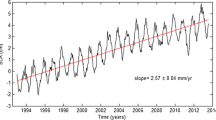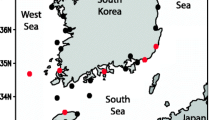Abstract
Sea-level is closely linked to the Earth’s climate and its change is important as a metric for global and regional climate change. Identifying, extracting, and revealing such information through detailed analysis is the prerequisite for understanding the mechanisms of sea-level change. The monthly- average tide-change records reported and examined in this paper are from 10 tide gauge stations distributed in the northwest margin of the Pacific Ocean, registered during the period 1965-2005. In particular, we have utilized the Second Order Blind Identification (SOBI) method to identify and the Empirical Mode Decomposition (EMD) method to extract the El Niño-Southern Oscillation (ENSO) signals imprinted in those tide gauge records; and subsequently, we have investigated the spatial-temporal characteristics of the extracted ENSO signals using wavelet analysis methods. The following results are obtained: (1) the ENSO events recorded by each tide gauge series are of different types and intensity, which show considerable temporal-spatial variation characteristics, with sea-level responses to ENSO signals remarkably stronger in low latitude areas than in medium-high latitude areas; (2) due to the influences of ocean currents, topographical conditions, and other factors, there exist variations in the type of relationship between the sea-level changes and the recorded ENSO events at different latitudes; (3) sea-level changes can also denote scale-variation characteristics of ENSO events, and particularly, since 1980s, all the tide gauges located south of Kanmen show intense responses to ENSO and the timescale of ENSO events extended gradually from around 4 years to 2–8 years, reflecting variations in the intensity and frequency of ENSO events; and (4) reverse changes of certain scale were noted before and after strong ENSO events recorded by sea-level changes, supporting the research findings about the interaction (mutual coupling and superimposition) between the probability of occurrence of strong ENSO events and their time scale.
Similar content being viewed by others
References
Cazenave A, Nerem R S. Present-day sea level change: Observations and causes. Rev Geophys, 2004, 42: RG3001
Munk W. Twentieth century sea level: An enigma. Proc Natl Acad Sci U S A, 2002, 99(10): 6550–6555
Peltier W R, Tushingham A M. Global sea level rise and the greenhouse effect: Might they be connected? Science, 1989, 244(4906): 806–810
Alley R B, Clark P U, Huybrechts P, et al. Ice-sheet and sea-level changes. Science, 2005, 310(5747): 456–460
Raper S C B, Braithwaite R J. Low sea level rise projections from mountain glaciers and icecaps under global warming. Nature, 2006, 439(7074): 311–313
Church J A, White N J, Arblaster J M. Significant decadal-scale impact of volcanic eruptions on sea level and ocean heat content. Nature, 2005, 438(7064): 74–77
Miller L, Douglas B C. Mass and volume contributions to twentieth-century global sea level rise. Nature, 2004, 428(6981): 406–409
Solomon S D, Qin D H, Manning M, et al, eds. IPCC, Climate Change 2007: The Physical Science Basis. Contribution of Working Group I to the Fourth Assessment Report of the Intergovernmental Panel on Climate Change. Cambridge and New York: Cambridge University Press, 2007
Cabanes C, Cazenave A, Le Provost C. Sea level rise during past 40 years determined from satellite and in situ observations. Science, 2001, 294(5543): 840–842
Nerem R S, Leuliette E, Cazenave A. Present-day sea-level change: A review. C R Geosci, 2006, 338, 1077–1083
Li K P, Zhou T H, Chen Z Y. Preliminary analysis on characteristics and probable factors of monthly mean sea level change along Chinese coast (in Chinese). Acta Oceanol Sin, 1982, 4(5): 529–536
Pu Y X. Seasonal variation of monthly mean sea level change along Chinese coast (in Chinese). Acta Oceanol Sin, 1988, 10(3): 270–278
Zuo J C, Yu Y F, Chen Z Y. The analysis of sea level variation factor along china coast (in Chinese). Adv Earth Sci, 1994, 9(5): 48–53
Chambers D P, Mehlhaff C A, Urban T J, et al. Low-frequency variations in global mean sea level: 1950-2000. J Geophys Res, 2002, 107(C4): 3026
Nerem R S, Chambers D P, Leuliette E W, et al. Variations in Global Mean Sea Level Associated with the 1997-98 ENSO Event: Implications for Measuring Long Term Sea Level Change. Geophys Res Lett, 1999, 26(19): 3005–3008
Kang S K, Cherniawsky Y, Foreman M G, et al. Spatial variability in annual sea level variations around the Korean peninsula. Geophys Res Lett, 2008, 35: L03603
Rong Z, Liu Y, Zong H, et al. Interannual sea level variability in the South China Sea and its response to ENSO. Glob Planet Change, 2007, 55(4): 257–272
Ji M, Reynolds R W, Behringer D W. Use of TOPEX/Poseidon sea level data for ocean analyses and ENSO prediction: Some Early Results. J Clim, 2000, 13(1): 216–231
Wyrtki K. El Niño-the dynamic response of the equatorial Pacific Ocean to atmospheric forcing. J Phys Oceanogr, 1975, 5(4): 572–584
Li L, Wimbush M. Sea level along the southeast coast of China during El Niño. Chin J Oceanol Limnol, 1988, 6(4): 330–333
Church J A, Whiter N J, Coleman R, et al. Estimates of the Regional Distribution of Sea Level Rise over the 1950-2000 Period. J Clim, 2004, 17(13): 2609–2625
Kim K Y, Wu Q. A Comparison study of EOF techniques: analysis of nonstationary data with periodic statistics. J Clim, 1999, 12(1): 185–199
Wallace J M, Rasmusson E M, Mitchell T P, et al. On the structure and evolution of ENSO-related climate variability in the tropical Pacific: Lessons from TOGA. J Geophys Res, 1998, 103(C7): 14241–14259
Proakis J G, Manolakis D G. Digital Signal Processing: Principles, Algorithms and Applications. 4th ed. New Jersey: Prentice-Hall Press, 2007
Monahan A H. Nonlinear principal component analysis: Tropical Indo-Pacific Sea surface temperature and sea level pressure. J Clim, 2001, 14: 219–233
Hsieh W W. Nonlinear canonical correlation analysis of the tropical pacific climate variability using a neural network approach. J Clim, 2001, 14: 2528–2539
Pierre C. Independent component analysis: A new concept. Signal Process, 1994, 36(3): 287–314
Hyvärinen A, Oja E. Independent component analysis: Algorithms and applications. Neural Netw, 2000, 13(4–5): 411–430
Gröchenig K. Foundations of Time-Frequency Analysis. Boston: Birkhäuser, 2001
Huang N E, Shen Z, Long S R, et al. The empirical mode decomposition and the Hilbert spectrum for nonlinear and non-stationary series analysis. Philos Trans R Soc A-Math Phys Eng Sci, 1998, 454(1971): 903–995
Aires F A, Chédin, Nada J P. Independent component analysis of multivariate time series: Application to the tropical SST variability. J Geophys Res, 2000, 105(D13): 17437–17455
Huang N E, Wu Z H. A review on Hilbert-Huang transform: Method and its applications to geophysical studies. Rev Geophys, 2008, 46: RG2006
An S I, Wang B. Interdecadal change of the structure of the ENSO mode and its impact on the ENSO frequency. J Clim, 2000, 13(12): 2044–2055
Fedorov A V, Philander S G. Is El Niño changing? Science, 2000, 288: 1997–2002
Woodworth P L, Player R. The permanent service for mean sea level: An update to the 21st century. J Coastal Res, 2003, 19: 287–295
Gary K, Honaker J, Joseph A, et al. Analyzing incomplete political science data: An alternative algorithm for multiple imputation. Am Political Sci Rev, 2001, 95(1): 49–69
Wolter K, Timlin M S. Measuring the strength of ENSO events? How does 1997/98 rank? Weather, 1998, 53: 315–324
Wolter K, Timlin M S. Monitoring ENSO in COADS with a seasonally adjusted principle component index. Proceedings of the 7th Climate Diagnostics Workshop, Norman, OK, NOAA/N MC/CAC, NSSL, Oklahoma Clim. Survey, CIMMS and the School of Meteor, University of Oklahoma, 1993. 52–57
Eduardo O, Ebeling W, Lanius K. MEI, SOI and mid-range correlations in the onset of El Niño-Southern Oscillation. Physica A, 2002, 310(3–4): 509–520
Choi S, Cichocki A, Belouchrani A. Second order nonstationary source separation. J VLSI Sig Proc Syst, 2002, 32: 93–104
Wu Z, Huang N E, Long S R, et al. On the trend, detrending, and variability of nonlinear and nonstationary time series. Proc Natl Acad Sci U S A, 2007, 104(38): 14889–14894
Torrence C, Compo G P. A practical guide to wavelet analysis. Bull Amer Meteorol Soc, 1998, 79: 61–78
Landerer F W, Jungclaus J H, Marotzke J, et al. El Niño-Southern Oscillation signals in sea level, surface mass redistribution and degree-two geoid coefficients. J Geophys Res, 2008, 113: C08014
Mitchum G T, Lukas R. Westward propagation of annual sea level and wind signals in the Western Pacific Ocean. J Clim, 1990, 3: 1102–1110
Qiu B, Joyce T M. Interannual variability in the mid- and low-latitude Western North Pacific. J Phys Oceanogr, 1992, 22: 1062–1079
He Y, White W B. Interannual variability of the Kuroshio frontal structure along its western boundary in the North Pacific Ocean associated with the 1982 ENSO Event. J Phys Oceanogr, 1987, 17: 1494–1506
Chambers D P, Mehlhaff C A, Urban T J, et al. Analysis of interannual and low-frequency variability in global mean sea level from altimetry and tide gauges. Phys Chem Earth, 2002, 27: 1407–1411
Raicich F. A review of sea level observations and low frequency sea-level variability in South Atlantic. Phys Chem Earth, Parts A/B/C, 2008, 33(3–4): 239–249
Dickey J O, Marcus S L, Hide R. Global propagation of interannual fluctuations in atmospheric angular momentum. Nature, 1992, 357(6): 484–488
Zheng D W, Ding X, Zhou Y H. Earth rotation and ENSO events: Combined excitation of interannual LOD variations by multiscale atmospheric oscillations. Glob Planet Change, 2003, 36: 89–97
Author information
Authors and Affiliations
Corresponding author
Additional information
Supported by Special Program for National Basic Research Program of China (Grant No. 2007CB416602), Special Program for National High Technology R & D Program of China (Grant No. 2009AA12Z205) and Major Program for the Fundamental Research of the Jiangsu Province in University (Grant No. 05KJA17001)
Rights and permissions
About this article
Cite this article
Yuan, L., Yu, Z., Xie, Z. et al. ENSO signals and their spatial-temporal variation characteristics recorded by the sea-level changes in the northwest Pacific margin during 1965–2005. Sci. China Ser. D-Earth Sci. 52, 869–882 (2009). https://doi.org/10.1007/s11430-009-0072-5
Received:
Accepted:
Published:
Issue Date:
DOI: https://doi.org/10.1007/s11430-009-0072-5




